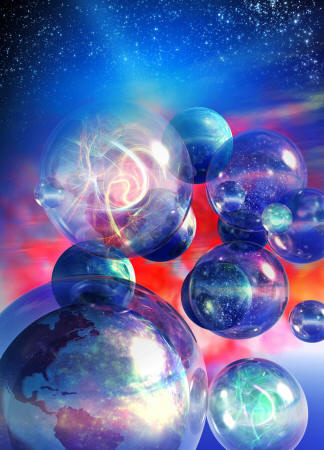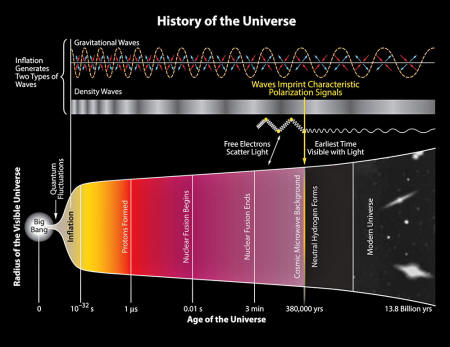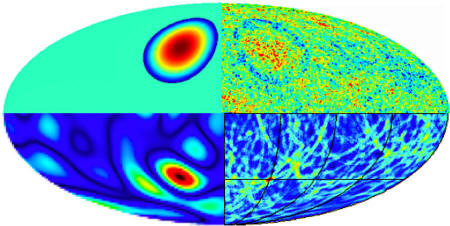|

by Miriam Kramer
March 18, 2014
from
Space Website

Our universe may be one of many,
physicists say.
The first direct evidence of cosmic
inflation - a period of rapid expansion that occurred a fraction of
a second after the Big Bang - also supports the idea that our
universe is just one of many out there, some researchers say.
On Monday (March 17, 2014), scientists
announced new findings that mark the first-ever
direct evidence of primordial gravitational waves - ripples in
space-time created just after the universe began.
If the results are confirmed, they would
provide smoking-gun evidence that space-time expanded at many times
the speed of light just after the Big Bang 13.8 billion years ago.

The bottom part of this
illustration shows the scale of the universe versus time.
Specific
events are shown such as the formation of neutral Hydrogen at
380
000 years after the big bang.
Prior to this time, the constant
interaction between matter (electrons)
and light (photons) made the
universe opaque.
After this time, the photons we now call the CMB
started streaming freely.
Credit: BICEP2 Collaboration
The new research also lends credence to
the idea of
a multiverse.
|
 |
|
Inflation is the mysterious force
that blew up the scale of the infant universe
from sub-microscopic
to gargantuan in a fraction of a second.
Credit: By Karl Tate, Infographics Artist
|
This theory posits that, when the universe
grew exponentially in the first tiny fraction of a second after the
Big Bang, some parts of space-time expanded more quickly than
others. This could have created "bubbles" of space-time that then
developed into other universes.
The known universe has its own laws
of physics, while other universes could have different laws,
according to the multiverse concept.
"It's hard to build models of inflation
that don't lead to a multiverse," Alan Guth, an MIT theoretical
physicist unaffiliated with the new study, said during a news
conference Monday.
"It's not impossible, so I think there's still
certainly research that needs to be done. But most models of
inflation do lead to a multiverse, and evidence for inflation will
be pushing us in the direction of taking [the idea of a] multiverse
seriously."
Other researchers agreed on the link
between inflation and the multiverse.
"In most of the models of inflation, if
inflation is there, then the
multiverse is there," Stanford University theoretical physicist
Andrei Linde, who wasn't involved in the new study,
said at the same
news conference.
"It's possible to invent models of inflation that
do not allow [a] multiverse, but it's difficult. Every experiment
that brings better credence to inflationary theory brings us much
closer to hints that the multiverse is real."
When Alan Guth and his colleagues thought up
cosmic inflation more than 30 years ago, scientists thought it was
untestable.
Today, however, researchers are able to study light left
over from the
Big Bang called cosmic microwave background radiation (CMB).
In the new study, a team led by John Kovac of the Harvard-Smithsonian Center for Astrophysics found
telltale signs of inflation in the microwave background.
The
researchers discovered a distinct curl in the polarization pattern
of the CMB, a sign of
gravitational waves created by the rapid expansion of space-time
just after the Big Bang.

If multiple universes exist,
they
may collide with each other and leave behind
signs in the cosmic
microwave background radiation, researchers say.
Credit: Stephen Feeney/UCL
Linde, one of the main contributors to
inflation theory, says that if the known universe is just one
bubble, there must be many other bubbles in the cosmic fabric.
"Think about some unstable state," Linde
explained.
"You are standing on a hill, and you can fall in this
direction, you can fall in that direction, and if you're drunk,
eventually you must fall. Inflation is instability of our space with
respect to its expansion.
"You have something growing
exponentially," he added.
"If you just let it go… it will continue
exponentially growing, so this [the known universe] is one
possibility of something going wrong with this instability, which is
very, very right for us because it has created all of our space.
Now, we know that if anything can go wrong, it will go wrong once
and a second time and a third time and into infinity as long as it
can go."
|





